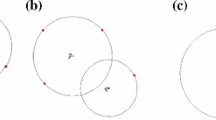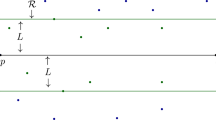Abstract
Barriers commonly occur in practical location and layout problems and are regions where neither travel through nor location of the new facility is permitted. Along the lines of (Larson and Sadiq, 1983) we divide the feasible location region into cells. To overcome the additional complications introduced by the center objective, we develop new analysis and classify cells based on number of cell corners. A procedure to determine the optimal location is established for each class of cells. The overall complexity of the approach is shown to be polynomially bounded. Also, an analogy is drawn to the center problem on a network and generalizations of the model are discussed.
Similar content being viewed by others
References
Aneja, Y. and M. Parlar. (1994). “Algorithms for Facility Location in the Presence of Forbidden Regions/or Barriers to Travel.” Transportation Science 28, 70–76.
Batta, R., A. Ghose, and U. Palekar. (1989). “Locating Facilities on the Manhattan Metric with Arbitrary Shaped Barriers and Convex Forbidden Regions.” Transportation Science 23(1), 26–36.
Berman, O., R. Larson, and S. Chiu. (1985). “Optimal Server Location on a Network Operating as an M/G/1 Queue.” Operations Research 33, 746–771.
Butt, S. and T. Cavalier. (1996). “An Efficient Algorithm for Facility Location in the Presence of Forbidden Regions.” European Journal of Operational Research 90, 56–70.
Dearing, P., H. Hamacher, and K. Klamroth. (2002). “Dominating Sets for Rectilinear Center Location Problems with Polyhedral Barriers.” Naval Research Logistics 49(7), 647–665.
Drezner, Z. (1995). Facility Location: A Survey of Applications and Methods. New York: Springer.
Edelsbrunner, H. (2001). Algorithms in Combinatorial Geometry. New York: Springer.
Francis, R., L. McGinnis, and J. White. (1992). Facility Layout and Location: An Analytical Approach. Englewood Cliffs, NJ: Prentice Hall.
Garfinkel, R., A. Neebe, and M. Rao. (1977). “The m-Center Problem: Minimax Facility Location.” Management Science 23, 1133–1142.
Hamacher, H. (1995a). Mathematische Lösungsverfahren für planaren Standortprobleme. Braunschweig: Vieweg Verlag.
Hamacher, H. (1995b). Verfahren der planaren Standortplanung. Braunschweig: Vieweg Verlag.
Hamacher, H. and S. Nickel. (1995). “Restricted Planar Location Problems and Applications.” Naval Research Logistics 42, 967–992.
Hamacher, H. and A. Schöbel. (1997). “A Note on Center Problems with Forbidden Polyhedra.” Letters of Operations Research 20, 165–169.
Hooker, J. (1986). “Solving Nonlinear Single-Facility Network Location Problems.” Operations Research 34(5), 732–743.
Hooker, J., R. Garfinkel, and C. Chen. (1991). “Finite Dominating Sets for Network Location Problems.” Operations Research 39(1), 100–118.
Katz, I. and L. Cooper. (1981). “Facility Location in the Presence of Forbidden Regions, I: Formulation and the Case of Euclidean Distance with one Forbidden Circle.” European Journal of Operational Research 6, 166–173.
Klamroth, K. (2000). “Single Facility Location Problems with Barriers.” Habilitation Thesis, University of Kaiserslautern, Germany.
Larson, R. and G. Sadiq. (1983). “Facility Locations with the Manhattan Metric in the Presence of Barriers to Travel.” Operations Research 31(4), 652–669.
Love, R., J. Morris, and G. Wesolowsky. (1988). Facilities Location: Models and Methods. New York: North-Holland.
Mitchell, J. (1992). “l1 Shortest Paths among Polygonal Obstacles in the Plane.” Algorithmica 8, 55–88.
Nickel, S. (1995). Discretization of Planar Location Problems. Aachen: Shaker Verlag.
Author information
Authors and Affiliations
Rights and permissions
About this article
Cite this article
Nandikonda, P., Batta, R. & Nagi, R. Locating a 1-Center on a Manhattan Plane with “Arbitrarily” Shaped Barriers. Annals of Operations Research 123, 157–172 (2003). https://doi.org/10.1023/A:1026175313503
Issue Date:
DOI: https://doi.org/10.1023/A:1026175313503




